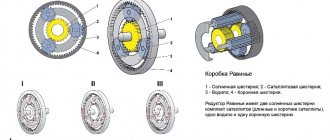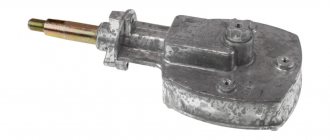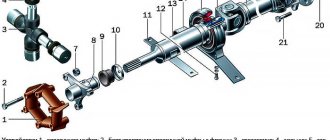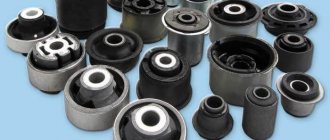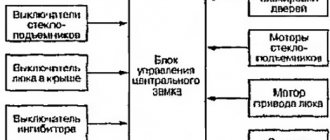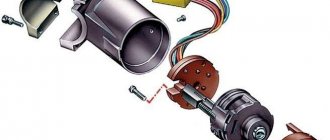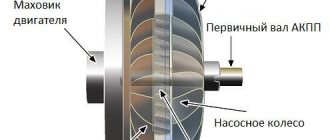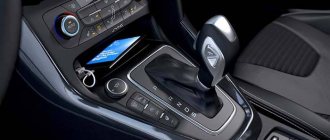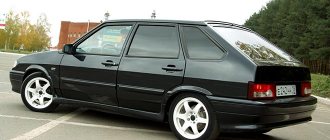How to prevent central locking failure?
Experts recommend regularly carrying out diagnostic work to identify all faults at the initial stage. A small wire crease can be eliminated in just a few seconds, which will allow the electrical circuit to maintain its functionality longer. Having the driver's supply of fuses will make it possible to repair the system in a short time, due to which the delay on the road will be minimal. With proper care, a central lock lasts much longer than a complex alarm system, and the security properties of the system are sometimes much better.
"Children's castle" in the car
Types, design and principle of operation of headlight range control
Children can behave unpredictably. If the driver carries a child in the back seat, then it is difficult to control the behavior of the small passenger. Curious kids may accidentally pull the car door handle and open it. The consequences of a small prank are unpleasant. To eliminate this possibility, a “child lock” was additionally installed on the rear doors of the cars.
This small but very important device prevents the door from being opened from the inside.
The method of activation of the mechanism depends on the make and model of the car. In some cases, the locking is activated using a lever, in others - by turning the spline. But in any case, the device is located next to the main door lock. For more information on using the child lock, please refer to your vehicle's owner's manual.
“Child lock” allows you to block the opening of doors from the inside and protect small passengers from falling out of the car
What to do if the central lock is frozen
In the harsh Russian climate in winter, it often happens that the central locks of cars simply freeze. Most often this happens when moisture gets into them, which is quickly “grabbed” by frost. If this happens, then you need to try to warm up the lock cylinders of the entrance (driver's) door in any possible and safe way. This can be done by carefully using a lighter or cigarette lighter borrowed from a nearby car. A very good remedy is a special chemical defrost. It is produced in small cans equipped with thin tubes, and is kept under pressure. After the driver's door is open, you can start the car and warm it up, after which the remaining interior door locks will gradually thaw.
Functions of remote controlled locks
Types, design and principle of operation of the ignition system
Fierce competition forces manufacturers to continuously work to improve remote-controlled locking devices, using new technologies, materials and original ideas.
Many remote control locks are equipped with additional functions. There are locking devices with a siren, which sound a loud alarm when an unauthorized person attempts to enter the premises. Some products are equipped with a fire alarm sensor.
Most locks with remote control can be equipped with the required number of remote controls.
Modern self-powered electronic locks monitor the condition of the batteries. When the supply voltage level critically decreases, an alarm is triggered. To control the remote control device in an emergency, power is supplied through a special connector or another alternative opening option is provided.
Lockitron brand remote control locks use a smartphone or other Android or iOS device with WiFi, NFC or Bluetooth as a key. Each Lockitron lock has its own web page. This high-tech product is capable of receiving commands from any corner of the planet. It transmits information to the owner in the form of SMS about each opening or mechanical impact on the door or the lock itself - a knock, an attempt to break into or damage to the door.
If necessary, the device is programmed to automatically open when the owner appears in the Bluetooth or NFC network coverage area.
Installation and connection of central locks
Types and principle of operation of a mechanical supercharger
Installing the central locking activator in the front door
Installation of the central lock should begin by removing the door trims and other elements that may interfere with installation. Then holes are drilled in each door to install a metal strip on which the door lock activator will be attached.
Having secured and adjusted the plastic activator, we move on to connecting and laying the wires. The task is to bring the wires into the car interior and connect them to the alarm unit.
In order to avoid moisture getting on the wires and further failure of activators and other devices (power windows, door lights), consider laying the wires along the door in advance.
Avoid placing wires at the bottom of the door, as this is where water tends to accumulate.
Central locking activator wire routing
When laying the wire, also pay attention to the most “problem” area, namely the place where the wires bend in the opening between the door and the body
Door wiring protection tube
The best option is to use a rubber tube through the pipe. This corrugation will protect the wiring from chafing and kinks.
For a competent approach to the matter, as well as in order to be able to easily identify and find the necessary wires (+12 Volts, ground, control outputs from the alarm unit), it is better to remove the instrument panel (dashboard) completely. Thus, you will not only simplify your work on laying wires, but you will also be able to connect, solder and insulate them without much difficulty.
On a VAZ 2106 car, the instrument panel can be removed quite simply (four self-tapping screws and four nuts).
Twist or solder wires?
We recommend purchasing female and male terminals, as well as a special tool for crimping wires. If the activator fails, you can easily replace it with a new one. To do this, you just need to disconnect the terminals, dismantle the old one and connect a working activator.
Twisting the wires and wrapping them with electrical tape is not a reliable option; in this case, it is better to “twist” + “soldering” + “heat-shrink tube”.
How to connect the central locking to the alarm system?
Since the VAZ 2101-2107 car is not initially equipped with a central locking or electric door lock drives, you can install additional electric drives and connect them to the system as follows.
Central locking connection diagram
The blue-white and orange wires of the 6-pin connector of the main unit of the alarm system are connected through 15A fuses to +12 V DC. Green and blue wires to the vehicle ground or, in other words, “ground”.
The white wire is to the blue door lock activator unlock wire, and the yellow wire is to the green power lock wire.
Most Chinese car alarms, especially inexpensive models (APS 2600 SHERIFF, Pantera CLK 355), have blocks similar in structure. Sometimes it seems that Chinese manufacturers only change the label, but the “filling” remains the same. At least, the 6-pin connector itself with power outputs for locks, as well as the colors of the wires, differ quite rarely.
Having familiarized yourself with the central locking connection diagram, feel free to start connecting the wires and checking the operation of the activators. After successful tests, all that remains is to assemble all the removed parts in place and then carry out a “control” check.
https://www.youtube.com/watch?v=7F8l0kOOrLk Job done, congratulations! The approximate cost is about 500 rubles, excluding the cost of the alarm system.
Installation of central locking
The procedure for installing a central locking system will not take much of your time and effort if the car was equipped with such a system at the factory. In this case, it is enough to purchase a special factory kit, and there will be no need to prepare seats for the mechanisms. But owners of older cars are out of luck in this regard. They need to do everything from scratch. The central locking installation process consists of several stages. This includes choosing a device, preparing the necessary tools, and the installation itself. Let's look at each of these stages in more detail.
Device selection
When choosing this element, you must first decide on the manufacturer. Many drivers prefer to save on purchases, preferring cheap Chinese analogues. In this case, there can be no question of any high-quality operation of the system. You should also pay attention to exploring the options: there is no point in paying for features that you most likely will not use. True, programming of the lock control functions occurs at the installation stage, so such functions do not need to be configured at all.
Among all the functions, it is worth highlighting the most useful and convenient ones. This includes the function of pressing car windows, but it is installed only on models with power windows. Often, passengers or the driver himself open the windows a little during the trip to ventilate the cabin, and upon arrival they remain unlocked. Another convenient function is that all door locks are locked when the vehicle is moving. It is especially useful for family cars.
Another unusual function of the central locking system is the automatic closing of all locks after 10 minutes. Of course, if the driver forgot to lock his car in the parking lot when going to the supermarket, then this function is certainly very useful. But what to do if the car keys were left inside? Sometimes the central locking may be activated immediately after starting the engine or even with slight pressure on the brake pedal. There can be many such nuances, so when choosing a device you should be extremely careful and painstaking.
Preparing tools
To install central locking, you need to prepare:
- central locking kit;
- side cutters;
- door piston;
- electrical tape;
- wiring;
- electric drill.
Having prepared everything for work, you can begin the process. Even if the lock was not installed at the factory, you can install it yourself as an addition.
Step-by-step instruction
By following the instructions below, you can install central locking on your car without any problems. And it doesn’t matter what brand or model you have, the main thing is desire, patience and, of course, free time. So let's get started.
Step 1. There is trim on the inside of the car doors. Remove it carefully, being careful not to damage the material.
Step 2. Now you can begin installing electric drives in the doors. The central locking kit must include a rod with a boom, which must be connected to the car door rod. The drive itself must be carefully attached to the car door, or rather, to its metal protruding part.
Step 3. Route the wiring to the central locking control unit. This must be done with extreme caution, and try to skillfully hide the wiring itself. If necessary, use zip ties or electrical tape to tie the wiring together in multiple places. When choosing the optimal location for installing the control unit, give preference to the most inaccessible places. The space under the dashboard is ideal for this.
Step 4: Reinstall the door trims. To do this, use door rivets (special clips made of plastic or metal).
Step 5. Once the door panel has been installed in place, you can begin connecting the wiring to the control unit - this is perhaps the most difficult and painstaking step in the central locking installation process. To do this, connect the negative wire to ground (it is black), and connect the positive wire to +12V (the “+” wire is colored red).
Step 6. Now start connecting the central locking system to the car alarm, thanks to which the doors will open and close automatically when the car is removed or armed using a special control panel. There is a fuse box under the hood of the car - connect the wires from the central locking to it. Everything must be done carefully and without haste, so as not to confuse anything. Here you may need pliers to strip the insulation from the end of the wire.
Step 7. Some car models differ in that their central locking is controlled using a key fob. If the system in your vehicle is powered by it, then in this case you can also connect the door locks to the central locking system. You just need to first arm or disarm the car with the alarm using the key fob, and then separately close or open the door locks. To do this, you need to use a special control panel from the central locking.
On a note! This scheme for connecting a central lock on a car usually takes from 1 to 3 hours, but over time the duration of the procedure may decrease. It all depends on the skill of the driver. Thanks to such manipulations, your level of protection increases significantly.
Schemes for connecting the alarm to the central locking system
The first of the possible options has already been considered: two wires are pulled from the central lock control unit to the signaling system, which are control wires.
Connection diagram of control unit central lock
In this case, it is better to exclude the contact switch shown in the diagram. Its role, as is easy to understand, will be played by the alarm (main unit). Where there are no separate taps, you can make T-shaped connections by connecting to the limit switch wires. This option is standard, but not the only one.
Standard option for connecting blocks
So, we have a lock control unit (CU Central Lock), as well as an alarm unit. The latter is equipped with a pair of relays, the taps of which are located on a separate connector. Where this connector is located, you need to find in the instructions (the wiring is also given there). The connection diagram will look like this:
Standard connection to central locking
The upper relay is activated to close the locks, the lower relay is activated to unlock the locks. During the period of contact closure, it is set to the following value: 0.7 s or 0.8 s.
Let us note two important points: a pair of relays is usually equipped with a unit of any modern alarm system. And by default everything is configured as it should. The central locking control unit, in turn, cannot but have control wires, and, as a rule, there will be two of them. Just in case, let's consider another option: there the limit switch is connected only to the signaling device.
When the decision is made by the alarm
Until now, we have used connection to the control wires coming from the limit switches to the control unit. Now they will need to be broken: the role of limit switches will now be performed by relays built into the signaling system, and we will connect one of the limit switch contacts directly to the signaling system.
Connection to control inputs
When the input labeled "IN1" is grounded, it means the following: the driver actuator is fully open. This is the logic that is usually used.
The work algorithm looks like this:
- We press the pawl on the driver's door, and input IN1 is immediately disconnected from ground;
- Seeing the lack of potential at the input, the signaling program activates the “close” option (the lower relay is activated for 0.8 s);
- As a result, the brown wire going to the central lock control unit experiences zero potential within 0.8 seconds, and automatic closure (locking) occurs.
A similar logic comes into play when the pawl is raised all the way up: the limit switch closes, and so on. Having implemented the indicated scheme, we will leave the central locking functionality in place, but will also add the ability to control the lock from the signaling system. This was also typical for the first option, but there were minor differences: two limit switches were used there, and the central control unit analyzed slightly more information. And here the analysis actions are assigned to the signaling.
Input IN1 is configured by software
All wires that need to be connected are low-current, and they carry 200-300 mA. Installing the cables will be simple: just create an electrical contact, and that’s it. But the power, that is, supply wiring, is not so easy to handle. Therefore, we saved the “difficult” option for last.
Connection to power terminals signaling
The actuator motor, which has built-in limit switches, can be connected to the alarm relay contacts. In this option, the electrical connection between the two blocks (control unit central locking and alarm) is completely absent:
Scheme 3, the most difficult
When carrying out installation, you may need to experiment with the polarity of the motor connection (points 1 and 2). The signal pushes the electric drive rod, and this leads to the switching of the limit switch contacts. And they, that is, the contacts, are always connected to the control unit, which provides indirect communication between the blocks.
In many cars there is no motor in the driver's actuator, but the central locking works as it should.
The circuit above uses similar logic. A positive property is the absence of galvanic connection. The negative is that you will need to connect power cords to the relay. It is better to entrust this work to an experienced auto electrician. There is no need to overestimate your strength.
Let's look at the last of the schemes again. There is a common contact between two different modules here, this is mass. Also, they are powered by one battery, and the second common conductor will be “+12 Volts”. But in the car, all the units are connected to these two cords. So, talking about the lack of electrical communication is quite legitimate. This option, if implemented at the proper level, will be the most reliable.
Children's castle
Also, in addition to a centralized door locking system, modern cars are often equipped with child locks. This was done for the simple reason that a child in a car can behave unpredictably, and due to his sluggishness and carelessness, he can fall out if he accidentally opens the door. Especially for this purpose, there are corresponding switches on the inside of the rear doors, when activated, it will be impossible to open the door from the passenger compartment. Typically, to activate the child lock, you must turn the switch using the car's original key.
These structural elements are installed on both sides and are operated separately. Such a device itself is located in close proximity to the standard door lock. It is worth noting that such mechanisms can only be deactivated or, on the contrary, set manually. It is impossible to remotely activate or vice versa disable the function, since it is necessary to turn the corresponding drive, which is responsible for the operation of the handle located in the car interior.
How is the castle built?
- the block through which the system is controlled;
- switches;
- executive equipment.
During operation, the control unit transmits electrical signals to actuators and analyzes the work being performed. The block decrypts the signal and further executes the given commands. Tasks can be transmitted to various parts of the car, provided that actuators are installed on them.
Switches are responsible for changing and fixing the position of locks. When a command is received from the block, microswitches paired with limit switches perform their work, thanks to which the executive equipment can perform the assigned tasks. Locking devices act as executive equipment. At the command of the block, the central locks open or close the machine and its various parts.
Central locking does not affect engine operation, unlike the alarm system. Blocking from the central locking control panel can apply to:
- door locks;
- window lifters;
- trunk;
- fuel tank cap.
The remote control key operates on batteries, so you need to check their charge regularly and replace them if necessary.
How to care for your central locking
The central locking mechanism does not require maintenance. It is advisable to ensure that no droplets of water remain in the locks when washing your car in winter. If you do not blow them through properly, the moisture will turn into ice in the cold, making it almost impossible to use the locks.
To avoid such troubles, you should not turn off the engine for an hour after washing, locking and unlocking the lock from time to time. During this time, the moisture will completely evaporate. You don’t have to let the engine idle, but immediately go out and ride for a long time. In this case, the next morning there will be no problems with opening car doors.
Surely you are already convinced that central locking is a useful thing. So if the machine is not yet equipped with such a control element, you can always install it if desired.
HOW TO INSTALL CENTRAL LOCKING WITH YOUR OWN HANDS
If you have long decided to upgrade your car by making closing and opening doors a fully automatic process, you will benefit from instructions on how to install central locking yourself.
PREPARATION
It all starts with preparation. To install the device, you will need at least four meters of two-core copper wire. Of course, you won’t be able to do without a tool chest either. In it you should have:
- screwdrivers,
- ticks,
- spanners,
- drill,
- pliers,
- drill.
Only having this entire set will you be able to efficiently install the entire structure. Also, during the preparation process, do not forget to check that all the necessary components are included in the purchased kit.
Attention! Do not buy a kit that is too cheap. It's better to spend a little more money but get reliable equipment that will last for many years.
INSTALLATION
Installation of the structure begins with removing the trim from each door. But before that you need to disconnect all the terminals from the batteries. This will allow you to install the system without the risk of receiving an electric shock. The following steps follow:
Remove the panels. Select a location for installation. The best place is considered to be the lower left corner. Otherwise, there is a risk that the glass will interfere with the operation of the locks. Install activators for the central locking. Connect the rods and activators and secure the clamps
It is very important to check the wiring when connecting each device.
Pull the wires. Use plastic clamps to secure them. Remove the dashboard
The same needs to be done with the old wires responsible for the operation of the power windows. Route new cables and connect them. Connect the drives and insulate them. Push the wires into the dashboard and glove compartment. Install the through pipe. Attach a fuse to the connector. This element must be connected to a common power supply. The resulting structure is mounted under the torpedo. Connect the central locking system to the car. The minus goes to the body, and the plus is connected to the fuse.
After this, the installation of the central lock can be considered complete, as you can see, there is nothing complicated about it. It is not surprising that most drivers decide to do it themselves.
Attention! After checking the functionality of the system, you can install the casing back, like the panels.
IMPORTANT NUANCES
When installing a central lock with your own hands, there are certain nuances that will help you do the job at the highest level. Here are the main ones:
- It is best to use a corrugated tube for pulling wires.
- Do not run wires along the bottom of the doors. This may cause a short circuit.
- To achieve better accuracy, the rod can be bent.
Just three recommendations will allow you to avoid common mistakes when installing a central lock with your own hands.
System components
Since central locking is, at its core, a fairly simple system, there are only a few main components. In particular, we are talking about the following elements:
- input sensors of the centralized system;
- electronic control unit;
- auxiliary actuator.
Of course, this system also includes a wiring kit that connects all components into a single network, allowing the driver not to make any effort to unlock all or individual car doors.
Input sensors
In this case, we are talking about limit switches - input sensors that allow you to transmit information, as well as the location of the doors at the current moment in time, and send information to the control unit, as well as microswitches. The latter determine the position of the mechanical components of the central locking at the moment of unlocking or locking during the activation process. It is noteworthy that two microswitches are responsible for fixing the cam mechanism. A separate switch in this case allows you to accurately determine the position of the lever mechanism in the lock drive. All this helps to accurately recognize in what position the doors are located in relation to the body at this moment.
Provided that the door is open, the system closes the contacts on the switches, after which the central locking function cannot operate. Next, the current information is transmitted directly to the control unit. It transmits everything needed to the actuators used to close the doors, as well as the trunk lid and the gas filler flap.
Electronic control unit
Like any other system, the central locking has its own control unit, which is responsible for the operation of the entire circuit. As soon as information from the input sensors arrives at the ECU, analysis occurs here, as well as subsequent distribution to the actuators. It is noteworthy that the electronic control unit also interacts with the alarm system. This in turn opens up the possibility of remote control of the system using an appropriate, programmed key fob.
Actuator
Another extremely important element of a centralized locking system or central locking system. In this case, we are talking about an actuator or the final link of the entire circuit, which in turn is directly responsible for blocking the doors. It is noteworthy that the actuator itself is a conventional electric motor operating on the basis of direct current. The device is combined with a simple gearbox and converts the action of a rotating electric motor into reciprocating movements of the lock cylinder. It is noteworthy that in addition to electric motors, some vehicles are equipped with a pneumatic drive. A striking example is the automobile brands Volkswagen and Mercedes-Benz. It is worth recalling that these devices were used previously, but have been abandoned in recent years.
What it is
Central locking (CL) is an automotive auxiliary device responsible for the safety of the vehicle. Its presence creates comfort, since pressing one button on the control panel allows you to unlock all the doors on the car without any key.
The central locking system includes:
- Control block. This is the first link in the chain, used in the system to transmit signals to the central unit and switches;
- input sensors. Many motorists know them under another name - microswitches. Their main task is to determine and fix the position of the trunk and door locks. The sensors are triggered after receiving a signal with a command from the control unit;
- actuators. These are trunk and car door locks that are activated by a microswitch.
On a note! The central locking functions independently of engine operation, since the control unit is powered in autonomous mode. A special battery is installed on the key fob.
How the central lock works
At the moment when the motorist closes the car door using the key and lock cylinder, a microswitch is activated, which in turn ensures the blocking of the circuit. This component transmits a corresponding signal to the door control unit, after which the information is sent to the central computer. Subsequently, the main control unit analyzes the readings and then redirects the signal to the remaining doors, as well as the trunk and fuel tank hatch. As for unlocking door locks, this procedure follows the same principle, but in reverse order.
In a situation where the car owner uses a remote key fob to lock the doors, the corresponding signal is sent to the antenna, which is directly connected to the central ECU. Then, from this control unit, the necessary signal is distributed to all doors, after which they are blocked. Also, when using the key fob, the alarm is immediately activated. It is worth noting that on some modern cars, at the moment when all the doors are locked using the central lock, the windows are also locked. Modern ECUs are programmed so that in the event of an accident, the locking will stop automatically. For this purpose, the car has a corresponding shock sensor.
How does central locking work?
The security system is controlled by one center, which is why the lock is called central. Thanks to signals coming from the center, the car doors, trunk, and top hatch are able to open and close at the right time.
In addition, the central locking serves as additional protection, because as soon as the car moves, all doors are blocked by the central locking, which is important for the safety of passengers.
Thanks to the central locking, the driver is able to control both the car and the alarm simultaneously.
Characteristics of the central lock
Central locking or central locking of a 4-door car is the general name for the protective components of car locking. The main purpose of a car's central lock is to simultaneously open and close four doors; sometimes the fuel tank can also be opened using the central locking key fob. Today, central locks on cars meet the requirements of comfort rather than protection, so it makes no sense to compare such a system with an alarm system. Central locking is installed for the convenience of the driver. You can find a description of how the system works and looks below.
Principle of operation
Central locking kit with block
The principle of central locking is to lock and unlock vehicle doors when you press the key fob button or turn the key in the door lock. When the driver turns the key, a special switch in the lock turns on, which is responsible for locking. The impulse from this switch is sent to the control unit - all actuators come into operation and this ensures almost instantaneous blocking of the car. As for the unlocking process, it is carried out in a similar way.
If necessary, this main unit can also be controlled using a key fob or a key with a button. In this case, the pulse will be transmitted contactlessly to the antenna and control unit. When the signal is processed, the central locking system will transmit the corresponding command to all actuators that will open or close the car doors. The central locking system works on such a principle that if the car gets into an accident, the locking system will be deactivated automatically. If everything is clear with the description of the operating principle of the device, let’s move on to the next point - a description of the parameters and functions.
Options and Features
If you install a lock in your car yourself, you won’t have to climb into the car every time and open and close all the doors in turn. This function is controlled using a key fob or key and is the main one. Another parameter worth noting is versatility. That is, the universal central locking is a set that consists of a five-wire drive, the central locking itself, two-wire drives, and a control unit. The operation of such a car's central lock is ensured by a key, and this system can be easily combined with any anti-theft installation.
System connection diagram
The central locking kit can be supplemented with a key fob, which allows you to operate the door controls at a certain distance. As a rule, according to the description of the operating instructions, this distance does not exceed 10 m. To make driving even more comfortable, you can install a central locking system on the luggage compartment, which will separately allow you to control the trunk door.
As you understand, the system can be controlled in two ways - mechanical (from the key) and remotely (from the key fob). If necessary, the driver can configure some safety options in the system. For example, you can configure automatic closure of the passenger compartment if the car speed exceeds 60 km/h.
Device
The central locking system includes input controllers, a control device, as well as actuators - actuators. The main purpose of the input controller is to fix the position of the car door and transmit an impulse to the control device. There are two switches on the so-called cam of the locking device - one of them locks the door, and the second one unlocks it. Another switch allows you to determine the position of the door.
All impulses from these switches are transmitted to the control device, which transmits this signal to the central unit. This block transmits pulses to blocks. As for the actuator or actuator, it is an electric motor connected to a gearbox. Depending on the central locking model, the system can also use a pneumatic drive - previously similar units were installed on Volkswagens and Mercedes, but today such designs are not used (the author of the video is SIMPLE THINGS).
Central locking in a car: what you need to know
Let's start with the fact that there are several types of such locks, which differ in a number of characteristics. Although they have the same task and boil down to controlling the locking of doors in the car, different central locking systems have certain differences.
Let's start with the fact that on older car models you could find a pneumatic central lock, but today such a solution is not used. All cars have electric central locks.
The basis is the central locking unit (central locking control unit), which interacts with certain sensors. Simply put, sensors determine the state of the doors (open or closed), after which the signals are sent to the central locking unit, analyzed, and then the system makes a decision on the necessary actions.
The design also includes an actuator (electric motor). The central locking motor performs the same function, but different versions may differ in traction force.
The simplest central locking works in such a way that when the driver gets out of the car and inserts the key into the driver's door cylinder, not only the driver's door will close, but also the locks of all doors will automatically operate (the door closing buttons are recessed). There is also often a special door lock button in the cabin, which allows you to wipe and lock the locks from the inside.
A more advanced version is the central locking with remote control. In this case, there is a separate remote control to control the door locks, making remote control of the central locking possible.
Such a central locking key fob allows you to transmit signals via a radio channel to the central locking control unit, which, in turn, sends signals to actuators (car door lock actuators). Also, if an accident occurs and the airbags are deployed, the central locking automatically unlocks the doors.
Universal central locking can be installed on any car. The installation kit includes:
- set of wires and cables;
- controller, fasteners;
- actuators;
- control panel (in some systems);
In practice, however, they usually select a central locking system that can be connected to a car alarm. In this case, the central locking remote control will act as an alarm key fob. Taken together, the combination of central locking + alarm + immobilizer is the very minimum that should be included in the anti-theft and security complex of any car.
In fact, after pressing the key fob button and arming the car, the central lock locks all doors. By pressing the disarm button, the central locking is activated in parallel and opens the car doors. It is quite convenient that the central locking works both with the ignition on and off.
Preparing for self-installation of central locking
The complexity of installation directly depends on the brand of car. But, in fact, cases when something needs to be filed and drilled out for a long time are rare. These mainly include long-lived cars, which are at least thirty years old. In most options, the car is already prepared for installation of the central locking system. All that remains is to put the kit in place. Well, the second side of the issue is the set itself. If you don’t want to dig around for a long time, buy universal locks. Installation is simple and you will find plenty of information on them.
What's in the basic kit?
We take the simplest universal kit. Control, in our case, will be carried out from a special key fob. Usually there are two. There is an option when the system will be activated by turning the key in the driver's door lock. You can also display a special button in the car interior. This additional option is very nice if you need to lock the doors while driving. It is not always convenient to use the control panel.
So, we purchase a universal lock kit, which in most cases includes:
- Four motors. They will be attached to the door. One of them with four wires is on the driver's door;
- Control block. We will subsequently connect all the wires to it;
- A set of wires of the required length. If you feel that there are not enough of them, buy additional ones immediately;
- Key rings, strips, screws, etc.
central locking
Necessary tools for work
Now we are assembling a tool that will be useful to us in our work. If there are no holes for mounting motors in the doors, then prepare a drill with a drill bit. Also needed: screwdrivers, a screwdriver, a knife, corrugated tubes (wires are laid through them to avoid chafing and the influence of external factors on the wiring) and electrical tape. We will rewind all exposed sections of wires with tape in order to avoid their contact with metal parts of the body.
The last thing to do before proceeding with installation is to remove the trim and dust curtains from all doors. Determine the location where you will mount the mechanism so that it does not interfere with the operation of the window regulators. If necessary, you will have to make an additional bracket.
Installation of central locking
All necessary preparations have been made, and you can begin to work. We attach the motors to the doors, remembering that we place the motor with four wires on the driver's door. We also install the control unit there.
Connection diagram
After installation, we check the correct interaction with the lock rod, which is responsible for opening and closing the door, and the smooth operation of the lock itself.
Let's move on to the wires. We pull them from each motor to the control unit. Think in advance about how to pull the wire from the rear right door. You can use the space under the seats. We connect them according to the circuit and perform the test. To do this, return the battery to its previous state. If you find any faults, first check that the connections are correct. The plus and minus outputs may be confused. When checking, it is better to be inside the car or not to close the doors. Once you restore battery function, the locks should work automatically.
Installed and connected motor
If you still want to make a lock control button, prepare the missing parts in advance. Additional wire and button. It can be embedded into the dashboard. Buy any button, for example, for a window regulator.
Installation of the central locking control button
We look for the black, brown and white wires under the side panel and connect to them. Alternatively, you can stretch the wires and connect to the electrical bundle from the central locking of the driver's door. And we carry out the rest of the connection according to the diagram.
Connection diagram for the central locking control button
Connection diagram for the central locking control button
It is absolutely not necessary to make this button on the panel. Again, it all depends on convenience. You can place it in the space between the front seats if the necessary electrics are there. Alternatively, the button can be embedded in the armrests on the doors.
The trunk can also be connected to the central locking. Which, by the way, will also significantly save your time and nerves. If you have a wiper on the rear window, then the necessary electrical wiring is already installed, and connecting will not be difficult. The main thing is not to forget that central locking still cannot secure your car one hundred percent. Such options must be used comprehensively and, of course, an alarm system must be installed.
Which central locking is better to choose?
So, when choosing a lock, you need to pay attention to its functionality, especially if the car does not have such a lock. The simplest lock can only open and close all car doors.
As a rule, in the simplest versions there is no separate button in the cabin or a remote control. The driver will need to recess the lock (closing) or pull it up (opening) on the driver's door in the old fashioned way.
This action will allow you to close or open all doors from the interior. From the outside, the central locking is activated when the driver opens or closes the driver's door with the key.
However, options with advanced functionality may include a separate remote control, as well as a special button in the cabin. But that's not all. More expensive central locks allow you to control the status of the doors in the car, each individually.
You can also control the lock of the trunk, hood or gas filler flap, and initiate closing of windows (closed) in the case of electric windows.
In practice, the ability to partially block the doors is very convenient if the driver often carries children in the car. Also, the ability to lock only individual doors improves security. For example, the ability to open only the driver's door and lock the rest reduces the risk of theft of things from the car, robbery, etc.
The additional functions of the central locking system are also very useful. For example, automatic locking of doors and trunk after the car accelerates to a certain speed.
The two-stage unlocking of car doors is also quite convenient (the first press on the remote control opens only the driver's door, and the second press all other doors). It would seem that when choosing, it is better to give preference to solutions with advanced functionality. However, in reality, it is quite possible to get by with a simple central locking system, which works in tandem with an alarm system, opening and closing the doors when a signal is received to arm or disarm.
Moreover, simple options are represented by a conventional mechanical central lock. This version is quite reliable, while a separate remote door lock is more complicated and may malfunction and fail more often.
Given that the remote control depends on the key fob or button on the key, problems can arise as a result of the batteries running out, the lock control buttons being damaged, etc.
In practice, today the best solution is considered to be a central lock combined with an alarm system. This option means that all security systems work together, it is convenient and practical. You can also select a set of equipment from one manufacturer, which eliminates device conflicts, connection difficulties, programming, etc.
If you are considering choosing a central lock for your car, you should not stop at budget options. Typically, such products do not last long; the lock may jam. If you purchase more expensive analogues, you should check the traction, fastenings, and inspect the entire set.
As a rule, a good quality lock cannot be cheap. However, some well-proven options include Tiger, Convoy and StarLine. Also, before purchasing, it is important to consider the type of mount and sufficient drive power so that the device works correctly in a car of a particular model and brand.
